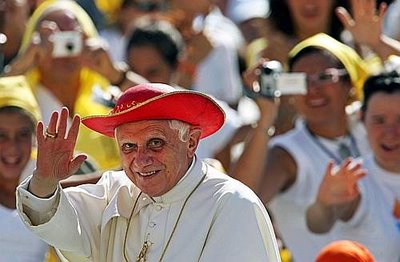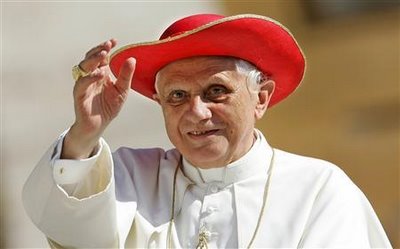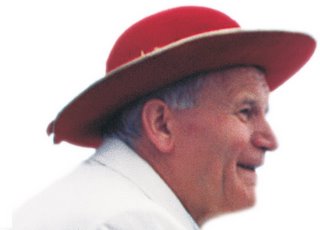Cardinal O'Malley on Daily Mass

I was very pleased to read the following on the Boston Cardinal's blog:
It’s the ideal that priests say Mass every day. It’s the greatest prayer that we can offer for the Church and for our people. That was why we were ordained. I would never miss the opportunity to say Mass. Each time we say Mass, the whole Church is present, even if we are alone.In the Mass we pray for the Pope, the other Bishops, for the living, for the deceased…everyone who has ever been part of the Church is part of the celebration of the Mass. It’s the greatest service that we can give.
So far, I've had the chance to say Mass every day since my Ordination - luckily when travelling to Australia I stopped off at Singapore and said Mass in a packed and very hot pilgrimage church. Anyway, what Cardinal O'Malley writes goes against the popular belief (in some quarters) that private Masses are to be discouraged, especially 'if we are alone.'
Labels: Liturgy, Priesthood







 They brought many of their patients to Christ but were finally condemned to death under Diocletian around the year 300. After various gruesome tortures they were beheaded, together with their other siblings Antimo, Leonzio and Euprepio.
They brought many of their patients to Christ but were finally condemned to death under Diocletian around the year 300. After various gruesome tortures they were beheaded, together with their other siblings Antimo, Leonzio and Euprepio. 





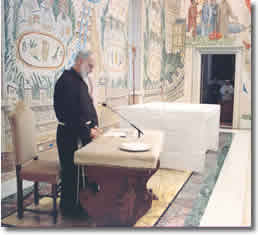
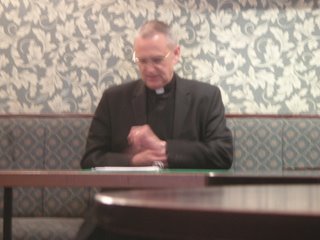






 Tower Green, of course, is not to be confused with Tower Hill, outside the walls of the fortress, where most Tower executions took place, including those of SS Thomas More and John Fisher and Blessed William Viscount Stafford.
Tower Green, of course, is not to be confused with Tower Hill, outside the walls of the fortress, where most Tower executions took place, including those of SS Thomas More and John Fisher and Blessed William Viscount Stafford.





 Here's the fake mantelpiece, above which you can see two large prints of SS Boniface and Willibrord (dating from 1714), an oval Agnus Dei (blessed by St Pius X) and a small eighteenth century painting of St Walburga. Below in a sort of converted bread bin is a zucchetto used by John Paul II during his pilgrimage to Great Britain in 1982 - it recently came into my possession and I'll take it into the diocesan archive soon. On the shelf are some of my favourite nic-naks - you know, the usual things like a model of the carriage in which Blessed Pius IX fled to Gaeta in 1848, a statue of St Nicholas, a bust of Pius XI and a Benedict XVI incense burner (you put an incense cone inside the figure and sweet-smelling smoke comes out of the mouth - I bought it at the Abbey of Diessen in February):
Here's the fake mantelpiece, above which you can see two large prints of SS Boniface and Willibrord (dating from 1714), an oval Agnus Dei (blessed by St Pius X) and a small eighteenth century painting of St Walburga. Below in a sort of converted bread bin is a zucchetto used by John Paul II during his pilgrimage to Great Britain in 1982 - it recently came into my possession and I'll take it into the diocesan archive soon. On the shelf are some of my favourite nic-naks - you know, the usual things like a model of the carriage in which Blessed Pius IX fled to Gaeta in 1848, a statue of St Nicholas, a bust of Pius XI and a Benedict XVI incense burner (you put an incense cone inside the figure and sweet-smelling smoke comes out of the mouth - I bought it at the Abbey of Diessen in February): Turn round and you'll see my (untidy) desk and the computer on which this blog is composed. The cupboard on the left stores my collection of relics and you can just see, on top of the far bookcases, some Venetian masks and an imitation Zulu War helmet.
Turn round and you'll see my (untidy) desk and the computer on which this blog is composed. The cupboard on the left stores my collection of relics and you can just see, on top of the far bookcases, some Venetian masks and an imitation Zulu War helmet. It's the perfect room for a twenty first century curate, full of gaudium et spes!
It's the perfect room for a twenty first century curate, full of gaudium et spes!
 Today the Holy Father visits Altötting, which for over a Millennium has been the spiritual centre of Bavaria. Although it is little known outside of Germany, it is listed as one of the ‘Shrines of Europe,’ together with Lourdes (France), Loreto (Italy), Fatima (Portugal), Czestochowa (Poland) and Mariazell (Austria).
Today the Holy Father visits Altötting, which for over a Millennium has been the spiritual centre of Bavaria. Although it is little known outside of Germany, it is listed as one of the ‘Shrines of Europe,’ together with Lourdes (France), Loreto (Italy), Fatima (Portugal), Czestochowa (Poland) and Mariazell (Austria). The Gnadenkapelle is said to stand on the site of a Roman Temple, later Christianised by St Rupert – indeed, tradition identifies this as the site of the baptism of Duke Theodo in 680. Certainly in the eighth century Altötting was a centre of the Bavarian court and the following century Duke Carloman founded a monastery there in honour of the Blessed Virgin.
The Gnadenkapelle is said to stand on the site of a Roman Temple, later Christianised by St Rupert – indeed, tradition identifies this as the site of the baptism of Duke Theodo in 680. Certainly in the eighth century Altötting was a centre of the Bavarian court and the following century Duke Carloman founded a monastery there in honour of the Blessed Virgin.











